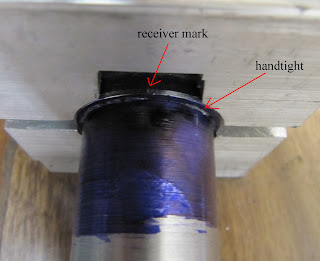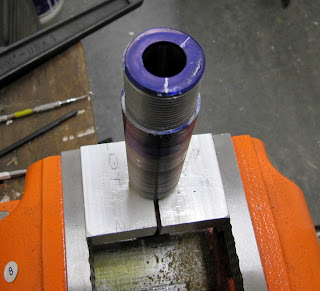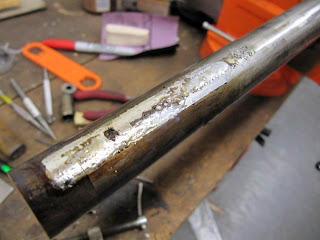So, this is a little bit delayed but it's a good update so it's worth the wait. As you may recall, the last build session ended with a barreled (but not tightened) receiver. This time we will continue the process with:
1. Extractor relief cut
2. Sights installation
3. Stock fitting
Here's the obligaotry "before" pic:
I made two barrel timing marks, one for a hand-tight fit and one for the final fit.
Here's the hand tight:
And here it is after tightening with a home-made action wrench and barrel blocks:
Looks like it went from about 0 to 2 o'clock, which I guess is kind of far (0 to 1 o'clock is desired). I suspect that the reason behind it is that the barrel shoulder wasn't sharp enough (90 degree ideal). No matter, it just had to be tightened a little further. At this point, another mark is made on the barrel to indicate how far to twitst to full-tight.
After marking the wrench-tight degree of twist we unscrew the barrel and mark the area to be removed for extractor relief. What should the extractor relief look like? Here's what an 91/30 izzy barrel barrel looks like. The 6 o'clock in the picture below corresponds to the bottom of the receiver. I am using a piece of steel wire to indicate the vertical center line. From here you can get an idea of the angular extent to which the extractor relief thould be cut (~135 degrees out of 360).
I then transferred the markings as faithfully as I could to the barrel blank. The extractor cut will be made in the mill. We do not have an indexing head and so this is the trick we used instead. The following picture shows an aluminum bar that I used to practice the cut before performing it on the barrel.
Notice the workstop in the back - this is what allows us to turn the bar in the mill vise without disrupting its position along the mill table. I will not show my practice work, but will instead move on to what I did to the barrel. First, the setup:
Here's where you want to zero the cutter by touching the top and face of the barrel. We will work by moving the cutter to and from ourselves. I started by making all sorts of fancy measurements on the factory barrel, but ultimately ended up simply taking the barrel out of the vise and checking it against the bolt until the extractor was cleared. Here are some pictures of the progress. You can also get an idea of how I was making the cuts from these.
This was supposed to clear the extractor according to my measurements, but alas. The pointy extractor tip was coming up against the surface cut in the last step above. I ended up having to remove most of that material in order to allow for sufficient extractor clearance. The removal was done in the same way as before. The "lip" went from this:
to this:
The lip is indeed pretty thin. Perhaps using a larger diameter endmill will allow more material to remain. I used a 1/8" ball-nose end mill for all the above operations.
The crown was done with Midway's .30 cal crowning tool (here) fitted with a custom-made (from an old Harbor Freight brass punch) pilot bushing. At this point, the barrel was screwed back in to the receiver to the wrench-tight mark made previously. It was now time to take care of the sights. The sights were ordered from Numrich - it was a cat-in-a-bag purchase, but ended up being discounted Williams front+rear sight combo (also available from Midway and Brownells). Make sure they are steel. Voland ordered his rear sight elsewhere and it turned out to be made from aluminum. As a result, we weren't able to solder it to the barrel. The curvature on the bottom had to be tediously fitted to the actual barrel diameter by running them over some sandpaper, which in turn was wrapped around the barrel. (I got some really bad blisters while doing this).
After a quick sanding of the surfaces to be mated, they were degreased with mineral spirits (not the best solvent for this - use acetone if you have it). For the solder we used soft solder from Midway (here) and this is how much I ended up putting on the bottom of the front sight. In retrospect I would say use about twice as much.
The sights were clamped onto the barrel with a C-clamp and heated with a mapp-gas torch. It took quite a bit of heat to get the solder to melt - it made me wish for an oxygen setup to speed things up. Embarassing note: even though I took the time to make sure the sights were "straight" they still ended up being "crooked". Here's a pic of the crooked front sight after soldering.
The fix? Take 'em off and do it again. Here are some pics of the solder after the sights were taken off.
The front sight has enough solder, but the rear is definately insufficient. The old solder was then sanded off and the soldering process was repeated, this time with much better results. Actually, I am skipping a step here, as chronologically - the stock was fitted before the sights were redone. I strongly recommend doing future builds in this order - that is - first stock then sights, as being able to put the action in the stock makes sight alignment much easier. Anyhow, here's wha the redone sights looked like:
Here is the stock fitting step that preceded the final sights installation. The stock was originally slightly longer than the end of the barrel, and for that reason it was chopped right in front of the front sling slot. The new barrel diameter was much larger than the original barrel channel and in order to make it fit material had to be removed. There are fancy tools out there for doing this, however, for doing only one build I chose to rely on the ol' sandpaper-aluminum pipe method. Pick a pipe with a diameter that is similar to the new barrel, wrap some coarse sandpaper around it and get to work. I also used a dremel with a large diameter stone for difficult to get areas.
This is what the rifle looked like after chopping the stock. Kind of ugly and bubba-esque.
The fitting process.
An intermediate stage in the inletting process.
After trimming to size, the front piece of the stock was re-attached as follows. Two holes were drilled into the main stock, into which two pieces of thick copper wire were inserted (with glue). I used a non-specialty glue that we had on hand - you on the other hand should spend some time and get the proper wood glue for this operation. To mark the location of the holes on the front piece, it was aligned and hit gently with a rubber mallet so that the copper wires make a mark on the wood. Holes were then drilled and the two pieces of stock were joined as shown below. A generous amount of glue was added between the two stock pieces.
(You can see the glue we used in the above picture)
After the glue had dried, this is what the joint looked like up close. The front piece then needed to be inletted in the same manner as the rest of the stock.
And here is a picture of the assembled rifle!
Now, it was time for a test fire!
The weather was very cold and beautiful, so I couldn't resist taking some artistic shots ;) Without any sights adjustments the rifle shot pretty close to center right out of the shop. After taking a few more shots I had the rifle dialed in almost perfectly. Later on, while transporting it to the range, the rear sight did come loose as the holding screws on it are very flimsy. I will stake it in place at a later date.
Finally, I will leave you with some action shots of the 45-70 Mosin vs a bowling pin. This was from a little less than 25 yards. Hope you enjoyed this long-overdue writeup. I'm looking forward to the next part of this build where we will work on the magazine and possibly stock refinishing and restoration.










































No comments:
Post a Comment